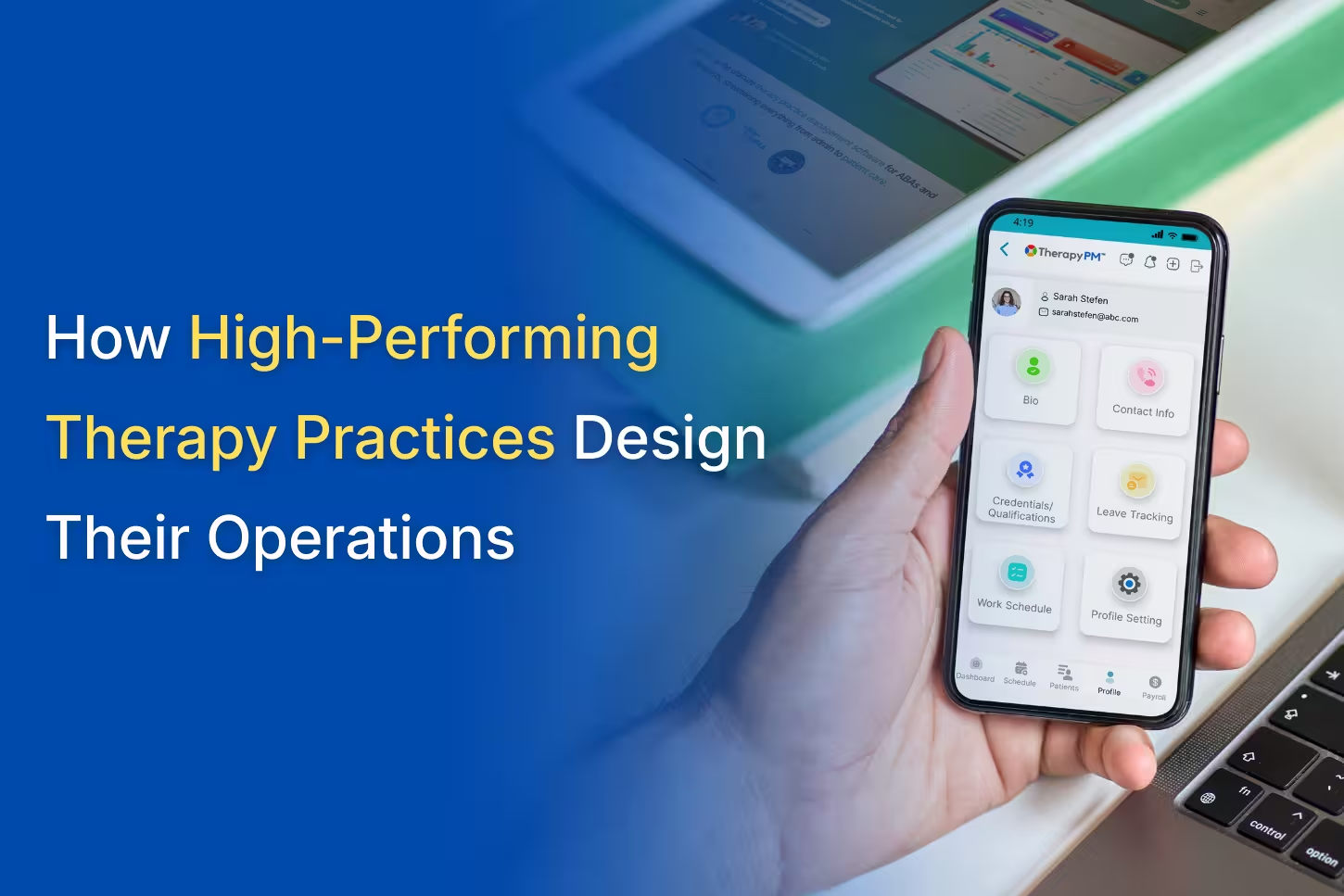
2026 TRICARE Updates: What Therapy Practices Need to Know
2026 TRICARE Updates: What Therapy Practices Need to Know 2026 has officially begun, bringing new updates across the healthcare industry, particularly within TRICARE. These annual
Holiday Special: Sign up for 1-Year Insurance Billing Services and get 6 months of software FREE

Occupational therapy plays a vital role in enhancing the quality of life for individuals facing physical, mental, or developmental challenges. However, the administrative burden associated with documenting occupational therapy can often impede therapists’ ability to focus on their core mission—providing effective therapy.
This challenging aspect not only hinders documentation but may also lead to poor medical data that are potentially misleading. “Poor medical data processing systems are the key reasons for medical errors.” Is there a way to prevent this and improve efficiency?
In this article, we will get to know how to unlock efficiency by streamlining the occupational therapy documentation process.
Occupational therapy is a healthcare profession focused on helping individuals overcome physical, mental, or developmental challenges to engage in meaningful daily activities. Occupational therapists work to enhance clients’ independence and improve their overall quality of life through tailored interventions and therapeutic techniques.
Documenting occupational therapy practice is crucial for tracking patient progress, ensuring quality care, and meeting regulatory standards. It provides a comprehensive record of interventions, assessments, and outcomes, facilitating communication among healthcare professionals. This enhances continuity of care and supports reimbursement processes.
The current landscape of occupational therapy documentation is characterized by a mix of traditional paper-based methods and electronic health record (EHR) systems. While EHRs have brought some advancements, several challenges persist:
Paper-based systems
Traditional Electronic Health Records (EHRs)
Time constraints and administrative burden
Compliance and Regulatory Challenges
Limited interoperability
Data security concerns
Billing and Reimbursement challenges
Need for data analytics
In essence, the current landscape highlights a pressing need for more efficient, user-friendly, and specialized solutions for documenting occupational therapy practice. This sets the stage for the exploration and adoption of more efficient systems to address these challenges and unlock greater efficiency in occupational therapy documentation processes.
Streamlining occupational therapy documentation is imperative to enhance overall patient care and healthcare system effectiveness. Let us look at the reasons in detail.
Enhanced patient care
Streamlining documentation allows therapists to focus more on direct patient engagement and personalized treatment plans. Reducing administrative burdens ensures timely and high-quality care.
Boosts therapist efficiency
Documenting occupational therapy efficiently saves therapists time, enabling them to allocate more effort to patient interactions. Standardizing documentation reduces redundancy and minimizes the risk of errors.
Improve communication among healthcare professionals
Streamlined documentation promotes better communication among healthcare professionals, ensuring a cohesive approach to patient care. Consistent and standardized records facilitate seamless information sharing within the healthcare team.
Maintain compliance and data integrity
Efficient documentation practices are crucial for meeting regulatory standards, such as those set by HIPAA. Standardization helps maintain data integrity, ensuring the accuracy and security of patient information.
Optimize workflows
Streamlined documentation of occupational therapy practice optimizes workflows, contributing to overall practice efficiency. Improved workflow ensures that therapists can manage caseloads more effectively.
Enhance the quality of care
By adopting streamlined documentation practices, occupational therapy can enhance the overall quality of care delivered to individuals facing physical, mental, or developmental challenges. The focus on efficient processes allows therapists to tailor interventions and treatment plans more effectively.
Therapy Practice Management Software (TPMS) emerges as a pivotal tool in revolutionizing occupational therapy documentation and overall practice efficiency.
1. Customizable documentation templates
Unlock precision in your therapy documentation with TherapyPM – The right occupational therapy documentation software! Tailored templates and customizable fields empower therapists, saving time and ensuring accurate, personalized records. Elevate your practice with TherapyPM today!”
2. Centralized patient information
3. Time-efficient scheduling and billing
4. Enhanced collaboration and communication
5. Compliance and Security Features
Elevate your therapy practice with TherapyPM – your trusted partner in compliance and security. Safeguard patient data with confidence through robust features compliant with HIPAA, HL7, SSL, ISO 27001, Imunify 360, and more.
Ensure regulatory adherence effortlessly and take control of your business securely.
6. Data analytics for informed decision-making
7. User-Friendly Interface
Integrating a Therapy Practice Management Software (TPMS) into an occupational therapy practice is a transformative process that promises efficiency, improves workflows, and enhances patient care.
However, like any significant technological adoption, the implementation of TPMS comes with its set of challenges. Overcoming these challenges is crucial to realizing the full potential of TPMS and ensuring a smooth transition for therapists and staff.
Challenge 1: Resistance from staff, especially therapists, to embrace new occupational therapy documentation software.
Solution: Conduct thorough training sessions to familiarize staff with the software interface, emphasizing its benefits in streamlining workflows and reducing administrative burdens. Provide ongoing support to address concerns and build confidence in using the system.
Challenge 2: Migrating existing patient data and integrating TPMS with other systems.
Solution: Collaborate closely with the TPMS provider to ensure a seamless data migration process. Conduct thorough testing to identify and address any integration issues. Provide support during the transition to prevent data discrepancies.
Challenge 3: TPMS might not meet the specific needs and workflows of the occupational therapy practice.
Solution: Choose a TPMS that allows customization of templates and features. Work closely with the software provider to tailor the system to the unique requirements of the practice, ensuring a personalized and efficient experience.
Challenge 4: Concerns about the security and privacy of patient information in a digital system.
Solution: Select a TPMS with robust security features, including encryption, access controls, and compliance with healthcare data protection regulations like HIPAA. Communicate these security measures transparently to reassure both staff and patients.
Challenge 5: Overcoming resistance to change among therapists and staff accustomed to traditional methods.
Solution: Engage staff in the decision-making process when selecting a TPMS, addressing their concerns and highlighting the benefits. Encourage open communication and create a positive narrative around the transition, emphasizing how TPMS will empower them in their roles.
Challenge 6: Implementing TPMS across the entire practice at once can be overwhelming.
Solution: Consider a phased implementation approach or pilot programs of occupational therapy documentation software in specific departments or locations. This allows for gradual adaptation, identifies potential issues early on, and facilitates a smoother transition for the entire practice.
Challenge 7: The need for continuous support and training post-implementation.
Solution: Establish a robust support system, including a dedicated helpdesk or IT support team. Provide ongoing training sessions to address new updates or features, ensuring that staff remains proficient and confident in using the TPMS.
Challenge 8: Obtaining feedback and making necessary adjustments to improve TPMS functionality.
Solution: Foster a culture of feedback where therapists and staff can share their experiences and suggestions. Regularly communicate updates and improvements based on user feedback, demonstrating a commitment to continuous enhancement.
We understand that implementing a new occupational therapy documentation software can be challenging, and at TherapyPM, we’re committed to making this transition as smooth as possible for you. Our user-friendly interface, coupled with a library of training resources, is geared towards providing you with a supportive and efficient implementation experience.
Recognizing the complexities involved, we offer a risk-free 30-day trial, ensuring you have ample time to explore our features without any financial commitment or the need for a credit card.
The initial phase of implementation may raise questions, and that’s why we provide access to support and training resources throughout your trial period. We empathize with the concerns related to transitioning from a trial to a paid subscription, and rest assured, all your work during the trial is seamlessly saved.
For those considering a switch from other platforms, we offer guidance and assistance to make the transition hassle-free. Our top-notch support services, including email, live chat, 1:1 video calls, and phone support, are always at your disposal, ensuring that you receive the assistance you need.
Following the integration of TPMS or occupational therapy documentation software, prioritize continuous documentation improvement. Establish standardized procedures and ensure staff adherence. Regularly review and update documentation templates to align with evolving therapeutic practices.
Conduct periodic training sessions focusing on the efficient use of TPMS documentation features. Implement a robust documentation review process to identify and address any discrepancies promptly. Foster a culture of documentation excellence, emphasizing the importance of accuracy and completeness. Leverage TPMS analytics tools to derive insights for refining documentation strategies.
Lastly, stay informed about software updates and implement them strategically, aligning documentation practices with the latest features and industry standards for comprehensive and effective record-keeping.
In summary, documentation holds a key role in effective occupational therapy, significantly impacting patient care and practice efficiency. The transition from recognizing challenges in the current documentation practices to embracing Therapy Practice Management Software (TPMS) marks a substantial shift.
With the integration of smart and intuitive occupational therapy documentation software like TherapyPM, practices can achieve seamless and efficient documentation, overcoming limitations Improved occupational therapy documentation directly translates to enhanced efficiency and, subsequently, better patient care.
Related Posts

2026 TRICARE Updates: What Therapy Practices Need to Know 2026 has officially begun, bringing new updates across the healthcare industry, particularly within TRICARE. These annual

The Financial Cost of Operational Chaos in Therapy Practices Most therapy practice owners are excellent clinicians, but many find themselves trapped in a frustrating paradox:

How High-Performing Therapy Practices Design Their Operations If you look at two therapy practices side by side, one that is struggling and one that is
Adding {{itemName}} to cart
Added {{itemName}} to cart